


Plate II illustrates the marked differences in form and spectra, while Plates III to VII show direct photographs of representative galaxies in three spectroscopic categories: the A-, F-, and K-systems. It can be seen that, although a considerable diversity in form exists for systems of the same spectral class, there is a definite basic similarity between form and spectrum. The A-systems illustrated in Plate III have the common characteristic of minor central concentration of light, the F-systems have a greater central concentration, and the K-systems have the greatest central concentration of all. In the case of the last named, the greatest contribution to the total luminosity is due to a large, amorphous central bulge that is absent in both the A- and F-systems, and which is first observed in the FG group. The central concentration of light in such F-systems as M 33 and M 51 is due principally to stars of earlier type than is the case in the K-systems; the structural appearance of the central region in the F-systems is also different from that in the K-systems.
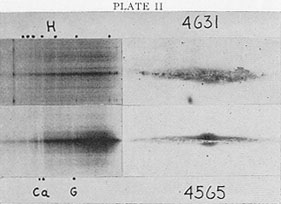
|
Plate II. Spectra (Lick) and direct
photographs (Mount Wilson-Palomar) of
an "A-system," NGC 4631, and a "K-system," NGC 4565. The spectra,
taken with the slit on the major axis of each galaxy, appear significantly
different. In the ultraviolet that of NGC 4631 shows strong
|
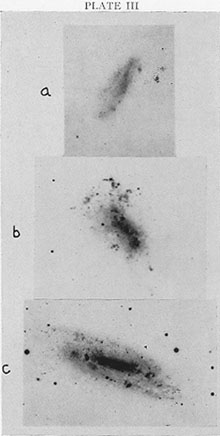
|
Plate III. Three A-systems: (a), NGC 1518; (b), NGC 4449; and (c), NGC 672, in which the main part of the light probably comes from A-type stars. There is no bright, amorphous bulge in any of these galaxies, nor any pronounced central concentration of light or well-developed spiral structure. The reproductions are from Mount Wilson-Palomar negatives. |
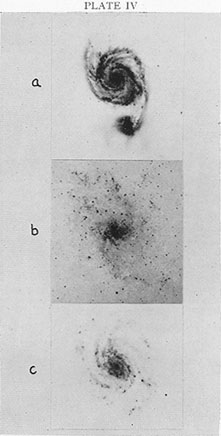
|
Plate IV. Three F-systems: (a),
NGC 5194 (M 51); (b), NGC 598 (M 33); and
(c), NGC 3810, which are intermediate in general appearance
between those
of classes A and K. The nuclear regions are appreciably more condensed
than those in A-systems, but still much less so than in K-systems. In the
range |
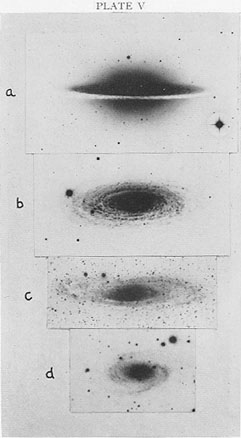
|
Plate V. Four normal spiral K-systems: (a), NGC 4594; (b), NGC 2841; (c ), NGC 224 (M 31); and (d), NGC 3031 (M 81), which have the common property of large, amorphous nuclear regions in which most of the light originates. The light from these central bulges comes largely from yellow and red giant stars of spectral types from gG8 to gM. The reproductions of NGC 2841 and NGC 4594 are from Mount Wilson-Palomar plates, those of M 31 and M 81 from Lick negatives taken with an f/7 Ross camera of 35 inches focal length. |
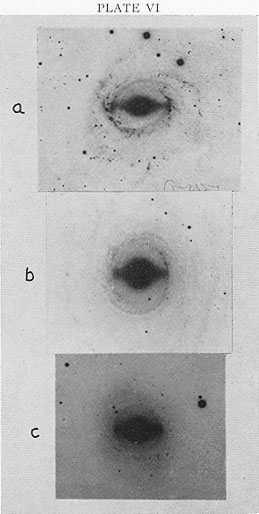
|
Plate VI. Three barred spiral K-systems (a), NGC 5850; (b), NGC 1398; and (c), NGC 4643, which have large, bright, and amorphous central bulges, and for which the spectral types are K in the blue-violet region. The reproductions are from Mount Wilson-Palomar plates. |
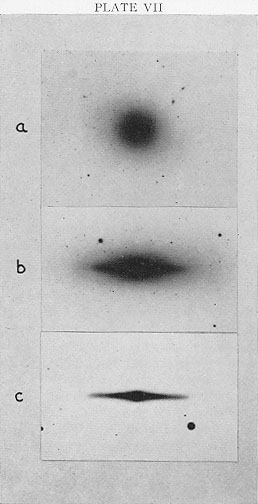
|
Plate VII. Three "dustless" K-systems: (a), NGC 4486 (M 87); (b), NGC 3115; and (c), NGC 4762, which are examples of galaxies that do not show evidence of dust lanes or spiral arms. M 87 is representative of the giant elliptical galaxies whose spectra are of type gK, as for the central parts of the spirals in Plate V. The spectral lines in the highest luminosity ellipticals also are abnormally broad, even more than in the nuclear region of M 31. In general form and appearance, NGC 4762 resembles an Sb galaxy without spiral structure outlined by dust. The reproductions are from Mount Wilson-Palomar plates. |